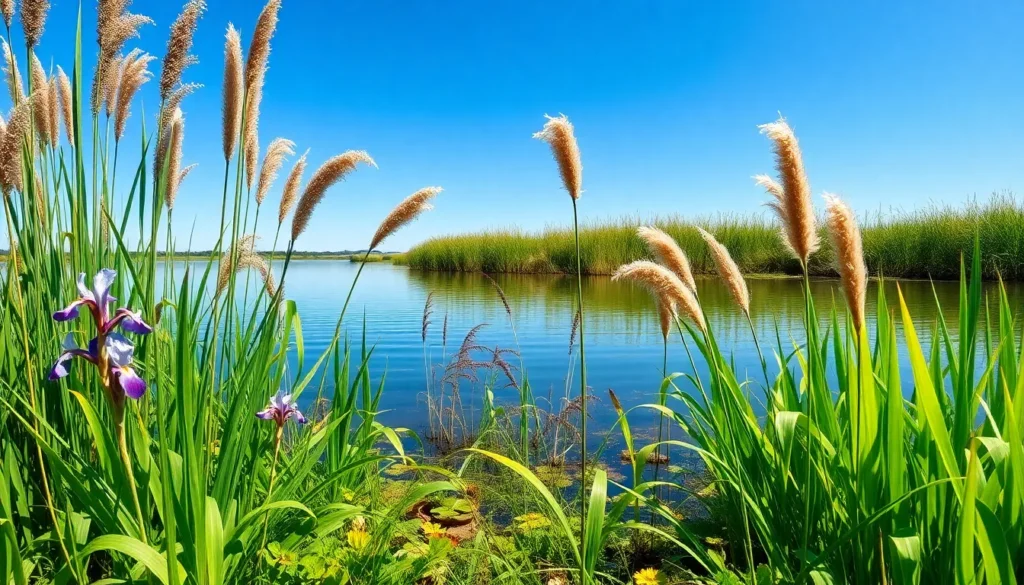Transform your pond from a simple water feature into a stunning aquatic oasis with the right edge plantings. We’ve discovered that choosing the perfect plants for your pond’s perimeter can dramatically enhance both its visual appeal and ecological health. The right combination of moisture-loving plants creates a seamless transition between water and land while providing essential habitat for wildlife.
Most pond owners struggle with creating that natural, polished look that makes their water feature the centerpiece of their industry. We’ll show you how strategic plant placement around your pond edge can solve common issues like erosion, algae overgrowth, and harsh visual transitions.
Whether you’re working with a small backyard pond or a larger water garden, we’ve compiled the most effective plant varieties that thrive in wet conditions and complement different pond styles. Let’s jump into creating the lush, professional-looking pond edge you’ve always envisioned.
Choose Native Aquatic Plants for Natural Pond Edge Beauty
Native aquatic plants create the most sustainable and beautiful pond edges while supporting local ecosystems naturally.
Select Region-Exact Species
Research local flora to identify plants that naturally thrive in your geographic area’s soil and water conditions. We recommend consulting your county extension office or local botanical society for comprehensive native plant lists exact to your zone.
Consider wetland species like blue flag iris (Iris versicolor) for northern climates or cardinal flower (Lobelia cardinalis) for eastern regions. These plants establish strong root systems that prevent erosion while creating stunning visual displays.
Visit nearby natural ponds to observe which species flourish without human intervention. Take note of plants growing at water’s edge in local parks, nature preserves, or wild areas.
Contact native plant nurseries in your area for species recommendations and availability. Local growers understand which varieties perform best in your exact microclimate conditions.
Consider Seasonal Growth Patterns
Plan for spring emergence by selecting plants with staggered growth cycles to maintain visual interest throughout the growing season. Early bloomers like marsh marigold provide color when other plants remain dormant.
Account for summer peak growth when choosing plant spacing and placement. Fast-growing species like cattails can quickly dominate smaller pond edges if not properly managed.
Prepare for fall dormancy by incorporating evergreen options such as sweet flag or winterberry holly for year-round structure. These plants maintain pond edge definition even after deciduous species die back.
Document bloom times for each selected species to ensure continuous flowering from spring through fall. Stagger plantings of similar species to extend individual bloom periods.
Evaluate Climate Tolerance
Assess winter hardiness by checking USDA hardiness zone ratings for each plant variety you’re considering. Choose species rated for at least one zone colder than your area for maximum survival rates.
Test drought resistance capabilities since pond water levels fluctuate seasonally. Plants like arrowhead (Sagittaria latifolia) adapt well to both standing water and temporarily dry conditions.
Monitor heat tolerance during summer months when water temperatures rise and evaporation increases. Select varieties that maintain healthy foliage even during extended hot periods.
Check flood resistance for plants positioned in areas prone to seasonal water level changes. Species like blue vervain (Verbena hastata) tolerate both wet and moderately dry soil conditions effectively.
Install Marginal Plants for Shallow Water Areas
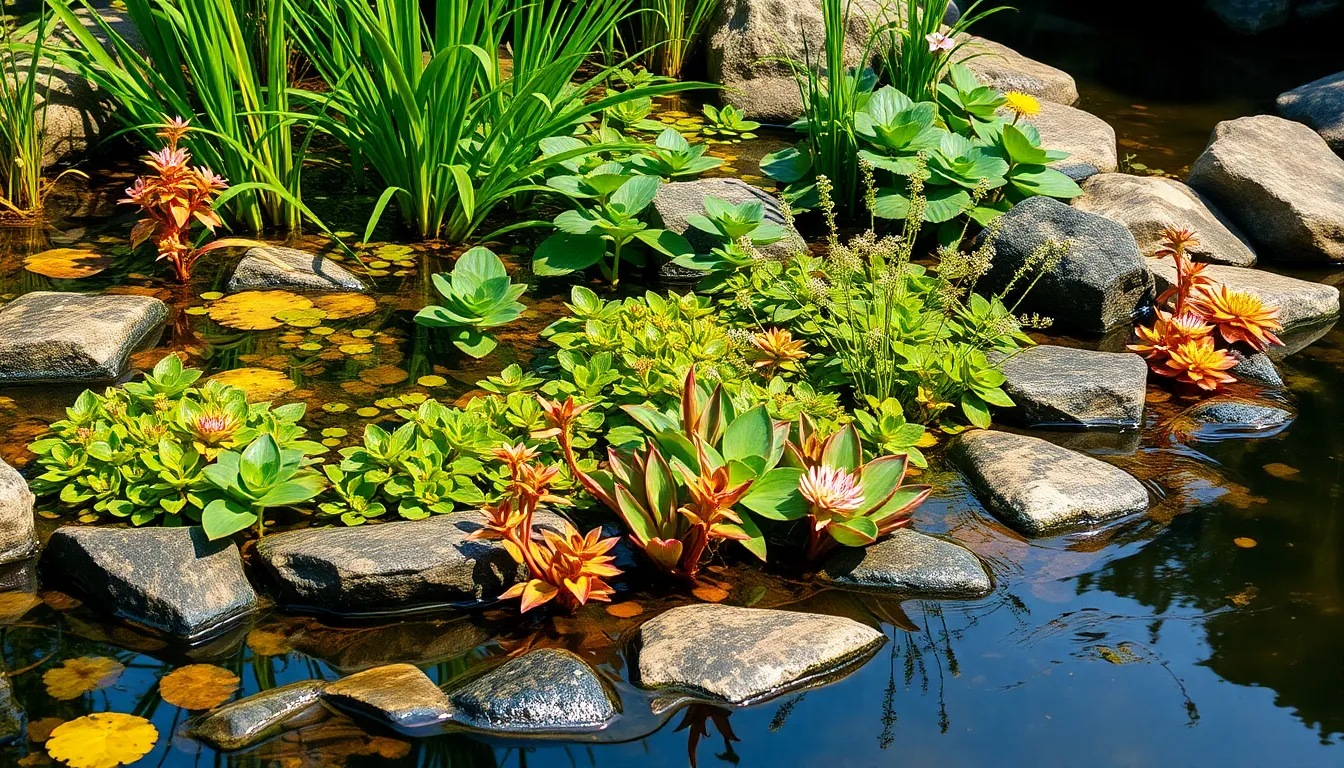
Marginal plants represent the perfect bridge between your pond’s aquatic environment and surrounding industry. These specialized plants thrive in shallow water conditions where their roots and growing points remain submerged while tolerating year-round waterlogged conditions.
Position Plants at Proper Water Depth
Each marginal plant species requires exact water depth measurements above its crown or growing point for optimal health. Plants labeled with 0–4 inch depth recommendations can flourish from wet soil conditions up to four inches of standing water covering their crowns. Exceeding these recommended depths can stress or kill your plants, making proper positioning crucial for long-term success.
We recommend using adjustable planting shelves or pot supports to achieve precise depth control for each species. Bricks or stable platforms work effectively to raise containers to appropriate heights within your pond. Monitor water levels seasonally since evaporation and rainfall can alter your carefully planned depths.
Space Plants for Optimal Growth
Natural groupings create more visually appealing pond edges than evenly spaced individual plants around the perimeter. Clustering multiple specimens of the same species together produces dramatic visual impact while mimicking nature’s growth patterns. Larger ponds benefit from substantial groupings that can be viewed from various angles and distances.
We suggest planning these clusters based on mature plant sizes rather than current container dimensions. Allow adequate spacing between different species groups to prevent aggressive spreaders from overwhelming slower-growing neighbors. Consider bloom times and foliage colors when arranging clusters to ensure seasonal interest throughout your pond edge.
Secure Root Systems in Pond Substrate
Proper anchoring prevents plant displacement from wind, wildlife activity, and water movement while maintaining healthy root development. Use aquatic substrate specifically designed for pond environments rather than garden soil that can cloud water or introduce unwanted nutrients. Line planting shelves to contain growing medium and prevent spillage into your pond’s main body.
Rock edging or natural logs around pond margins create defined planting zones while protecting root systems from disturbance. These materials also provide additional weight to stabilize plant containers during storms or when waterfowl visit your pond. Ensure all supports remain stable and won’t shift over time as plants establish and grow larger.
Incorporate Bog Plants for Moist Soil Conditions
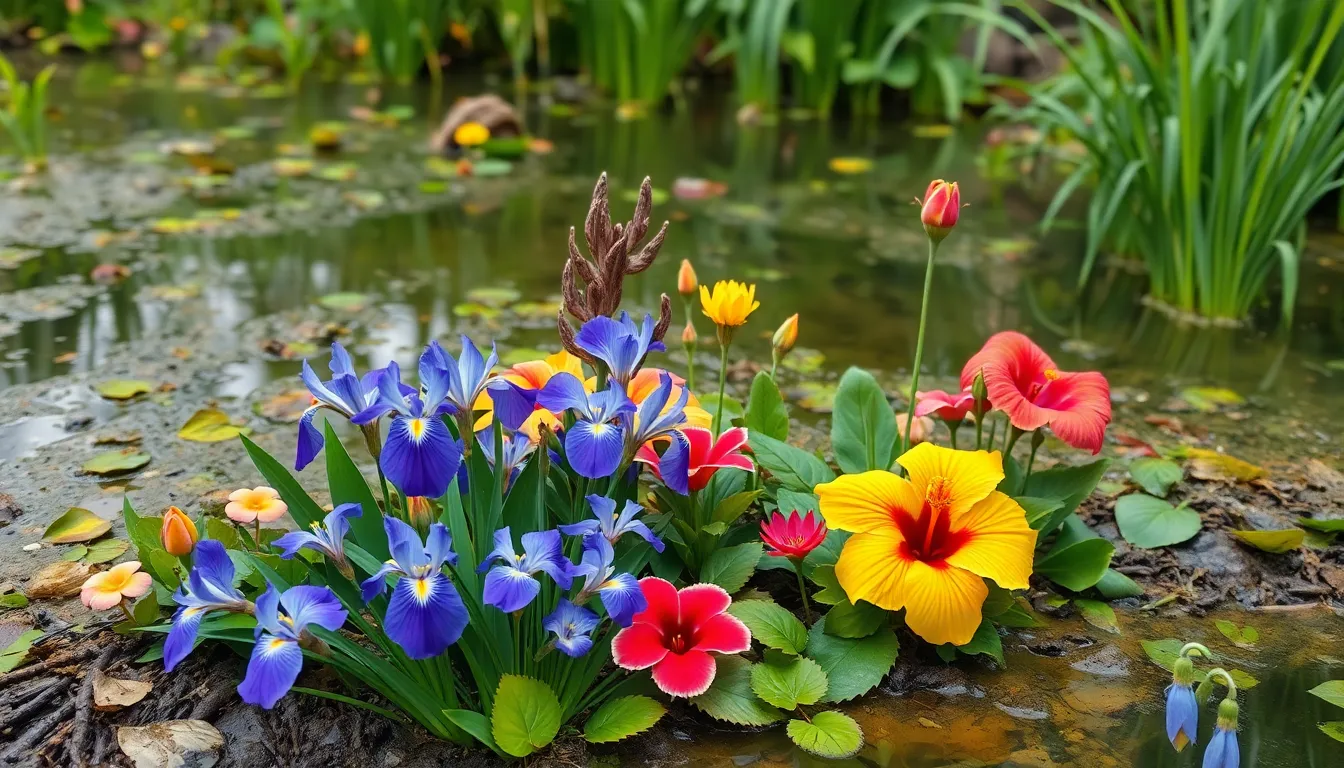
Bog plants excel in the consistently moist soil conditions found at pond edges, creating natural transitions that support both aesthetics and network health. These specialized plants have adapted to wet, often acidic soils where minimal water flow creates nutrient-poor conditions.
Identify Consistently Wet Areas
Successful bog plant installation begins with mapping areas that remain saturated year-round. We should focus on pond margins and natural depressions where water naturally accumulates, as these spots provide ideal growing conditions for moisture-loving species.
Walking around our pond during different seasons helps us identify which zones stay consistently wet versus those that dry out periodically. Natural water collection points like small hollows or areas where runoff gathers offer prime real estate for bog plant establishment.
We can test soil moisture by digging small holes in potential planting areas and observing how quickly water fills them. Areas where water appears within 6 inches of digging typically indicate suitable bog conditions.
Plan for Seasonal Water Level Changes
Water levels near pond edges fluctuate dramatically due to rainfall patterns and drought cycles throughout the year. We must select plants that can tolerate these varying moisture conditions to ensure long-term success.
Some bog species like Hardy Hibiscus can survive short dry spells while still preferring consistently moist conditions. Others require permanent wet feet and should be positioned in the most reliable moisture zones.
Documenting seasonal water patterns helps us understand which areas experience the most dramatic changes. We should place drought-sensitive species in locations that maintain moisture even during dry periods, while positioning more adaptable plants in transitional zones.
Creating a simple moisture map of our pond edge allows us to match plant requirements with actual site conditions. This planning prevents plant stress and reduces maintenance needs over time.
Group Plants by Moisture Requirements
Organizing plants into moisture zones creates healthier growing conditions and simplifies long-term maintenance. We can establish three distinct planting areas based on water tolerance levels.
Wettest zones accommodate true bog plants that thrive in saturated, acidic soils. Species like bog rosemary, turtlehead, and blue flag iris excel in these permanently wet conditions where most other plants would struggle.
Moist zones support perennials that tolerate soggy to moist soils without requiring constant flooding. Plants like astilbe, hostas such as blue ‘Halcyon’, Ligularia dentata, and Eupatorium cannabinum perform well in these moderately wet areas.
Drier edges work best for shrubs and plants preferring moist but not saturated conditions. Buttonbush (Cephalanthus occidentalis) fits perfectly in these transitional areas, providing structure while tolerating variable moisture levels.
Gunnera manicata, with its massive leaves, creates dramatic focal points in boggy areas with moist, well-draining soil. This grouping strategy helps maintain plant health while creating visually cohesive planting schemes that look natural and require less intervention.
Design with Ornamental Grasses for Texture and Movement
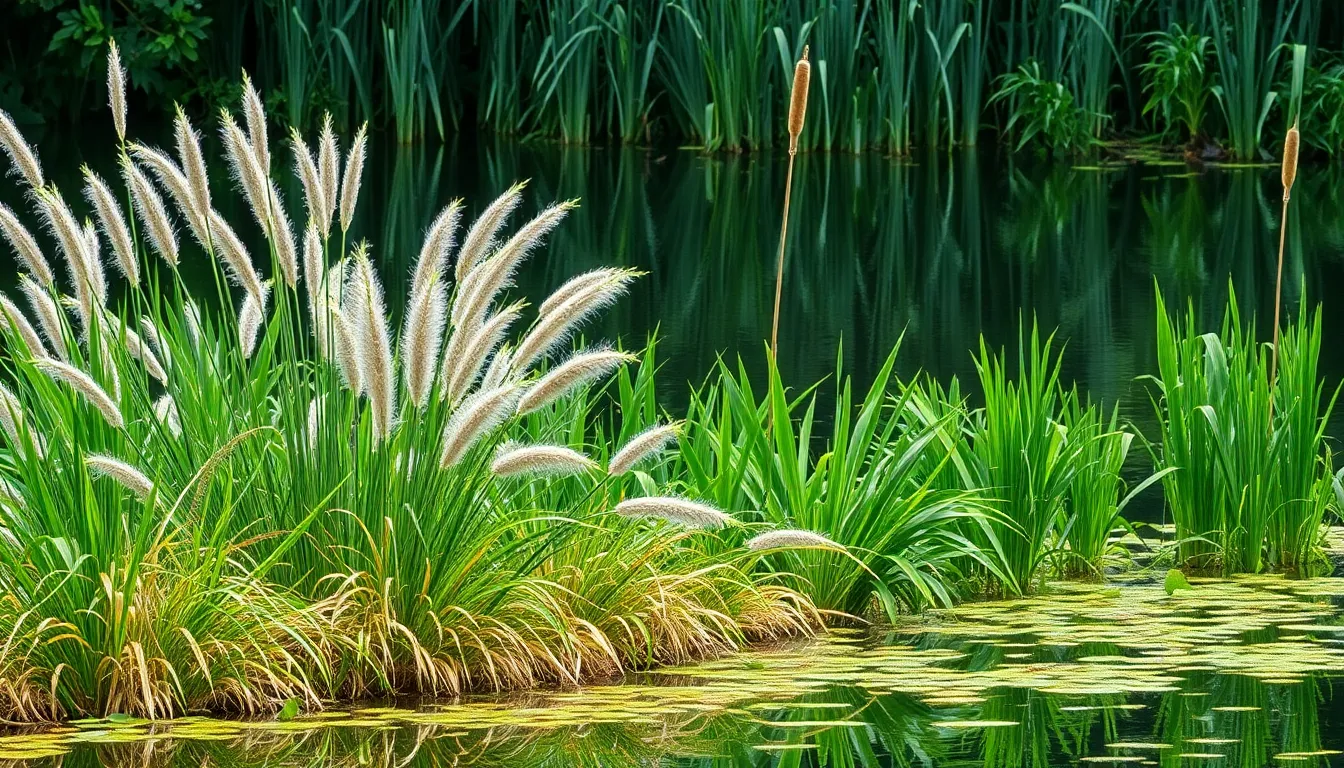
Ornamental grasses transform pond edges by adding ever-changing movement and textural contrast that complements the water’s surface. Their graceful, arching forms sway with every breeze, creating a living sculpture that brings energy to your pond industry.
Select Fountain Grasses for Vertical Interest
Fountain grasses excel at providing height and visual structure around pond edges. Their upright growth habit creates vertical accents that contrast beautifully with low-growing plants and horizontal water surfaces. We recommend positioning these grasses strategically to frame views and add dimensionality to your pond’s profile.
Graceful arching leaves and airy flower plumes make fountain grasses particularly effective for softening hard pond edges. These ornamental features persist through multiple seasons, ensuring your pond maintains visual interest even during dormant periods. Plant them in clusters of three to five for maximum impact and to create natural-looking drifts.
The vertical form creates dramatic silhouettes against water surfaces, especially during golden hour lighting. Consider spacing fountain grasses 2-3 feet apart to allow each plant’s natural shape to develop fully. Their feathery texture catches light and shadow beautifully, adding depth to your pond’s visual composition.
Add Sedges for Natural Pond Appearance
Sedges blend seamlessly into natural pond environments, reinforcing the wild, organic look many pond owners desire. These grass-like plants thrive in moist conditions and tolerate varying water levels better than most ornamental grasses. We find sedges particularly valuable for creating transitions between true aquatic plants and terrestrial species.
Natural habitat value makes sedges excellent choices for wildlife-friendly pond designs. They provide nesting materials for birds and shelter for beneficial insects while maintaining their attractive appearance throughout the growing season. Most sedge varieties handle seasonal flooding and drought conditions with minimal maintenance requirements.
Plant sedges in irregular groupings rather than formal rows to enhance their natural appearance. They establish quickly in pond edge conditions and spread gradually to fill gaps, creating cohesive groundcover over time. Their fine texture complements broader-leaved pond plants while maintaining visual continuity around the water’s perimeter.
Include Cattails for Traditional Water Garden Look
Cattails evoke the classic water garden aesthetic with their tall, slender stems topped by distinctive brown flowering spikes. These traditional wetland plants create instant recognition as pond features and establish strong vertical elements in your water garden design. We recommend cattails for pond owners seeking that quintessential marsh appearance.
Traditional water gardens benefit from cattails’ natural water filtration capabilities alongside their visual appeal. The dense brown flowering spikes provide wildlife shelter while the extensive root systems help stabilize pond edges against erosion. Plant cattails in contained areas to prevent aggressive spreading in smaller pond settings.
Tall stems reaching 3-6 feet create dramatic backdrops for lower-growing pond plants. Position cattails where their height won’t overwhelm smaller features, typically along the pond’s back edges or corners. Their distinctive silhouettes photograph beautifully and serve as focal points throughout multiple seasons.
Plant Flowering Perennials for Seasonal Color
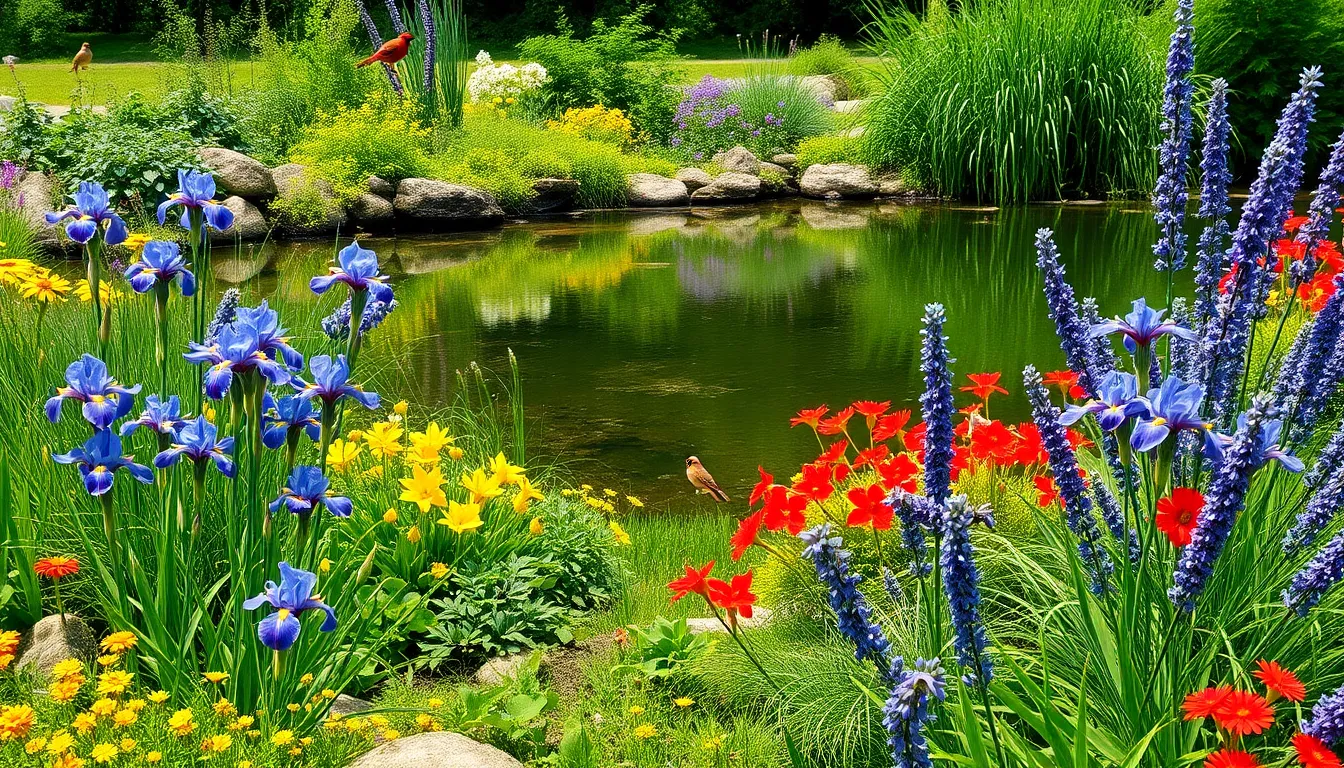
Flowering perennials transform pond edges into vibrant seasonal displays while supporting local wildlife and pollinators. We’ll explore three exceptional water-loving perennials that thrive in moist pond edge conditions.
Choose Water-Loving Iris Varieties
Water-loving iris varieties create stunning vertical displays that thrive in pond edge conditions. Louisiana iris cultivars offer exceptional durability, tolerating roots submerged up to 4 inches deep while producing striking blooms in multiple colors. Iris laevigata stands out for its versatility, growing successfully both above the water line and in slightly submerged conditions.
Flag irises and Iris pseudacorus add bold yellow and white blooms that create natural wildflower aesthetics around pond margins. These hardy perennials prefer acidic, moist soil with full sun exposure and require minimal maintenance beyond occasional composting or fertilizer applications. Container planting works exceptionally well for iris varieties, allowing us to adjust placement for optimal growing conditions.
Blue, yellow, and white iris flowers provide striking color combinations that complement other pond edge plantings throughout the growing season. Most iris species establish quickly in pond edge environments and return reliably each year with proper care.
Incorporate Cardinal Flower for Hummingbird Appeal
Cardinal flower (Lobelia cardinalis) delivers brilliant red summer blooms that attract hummingbirds to pond areas. This perennial thrives in the moist to wet soil conditions naturally present at pond edges, making it an ideal choice for wildlife-friendly landscaping. Vivid red spikes create dramatic color contrasts against blue iris blooms and green foliage.
Summer flowering periods coincide with peak hummingbird activity, providing essential nectar sources for these pollinators. Cardinal flower’s upright growth habit adds vertical interest without overwhelming smaller pond edge plants. Native status in many regions makes this perennial an excellent choice for supporting local ecosystems.
Established plants return each year and often self-seed in favorable conditions, creating natural colonies over time. Consistent moisture levels ensure healthy growth and abundant flowering throughout the summer months.
Add Pickerel Rush for Blue Summer Blooms
Pickerel rush (Pontederia cordata) produces distinctive blue-purple flower spikes that enhance pond edges with rich summer color. This aquatic perennial grows successfully with roots in water and leaves emerging above the surface, making it perfect for pond margin planting. Blue-purple blooms complement yellow iris flowers and red cardinal flower displays.
Partially submerged growth habits allow pickerel rush to thrive in areas where other perennials might struggle with excessive moisture. Summer flowering periods provide extended color when many other pond plants have finished blooming. Dense growth patterns offer valuable shelter and food sources for aquatic wildlife and bird species.
Established pickerel rush colonies support pond network health through natural water filtration and habitat creation. Hardy nature and minimal care requirements make this perennial an excellent choice for low-maintenance pond edge gardens.
Establish Ground Cover Plants for Erosion Control
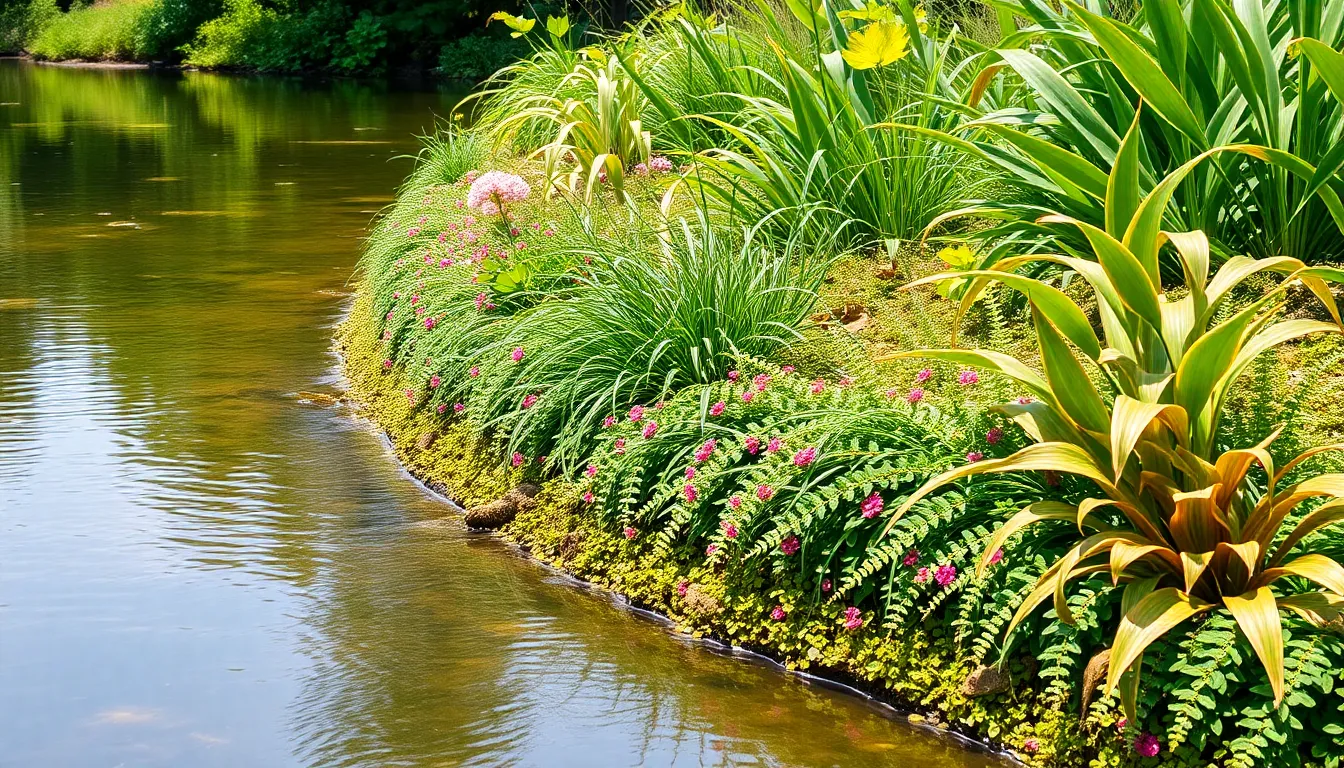
Ground cover plants form the foundation of effective pond edge stabilization by creating dense root systems that prevent soil displacement. We recommend these essential varieties to protect your pond’s shoreline while improving its natural beauty.
Use Creeping Jenny for Quick Coverage
Creeping Jenny (Lysimachia nummularia) spreads rapidly across pond edges, forming dense mats that stabilize soil within a single growing season. We’ve found this low-growing perennial excels at covering bare areas where erosion threatens the pond’s structural integrity. Its shallow root system creates an effective barrier against water movement while tolerating both saturated soils and periodic flooding.
The plant’s trailing stems root at nodes as they spread, creating multiple anchor points that hold soil in place during heavy rains or wind-driven waves. We recommend spacing Creeping Jenny plants 12-18 inches apart for complete coverage within one year. This vigorous grower requires minimal maintenance once established and provides year-round erosion protection with its persistent foliage.
Plant Sweet Flag for Grass-Like Texture
Sweet Flag (Acorus spp.) delivers the visual appeal of ornamental grass while providing superior erosion control through its robust wetland root system. We choose this plant for pond edges where grass-like texture is desired but traditional turf grass fails in saturated conditions. Its fibrous roots penetrate deep into waterlogged soils, creating stable growing conditions that typical grasses cannot match.
The plant thrives in consistently moist to shallow water conditions, making it perfect for areas where water levels fluctuate seasonally. We’ve observed Sweet Flag maintaining its attractive foliage even when partially submerged, unlike conventional grass species that deteriorate in wet conditions. Its dense clumping growth habit creates natural barriers that slow water flow and trap sediment before it reaches the pond.
Install Water Canna for Tropical Appeal
Water Canna (Canna spp.) combines stunning tropical aesthetics with practical erosion control benefits through its extensive root system. We select these marginal plants for pond areas that need both visual impact and bank stabilization in wetter zones. Their large rhizomes create substantial underground networks that anchor soil effectively while supporting impressive above-ground displays.
The plant’s broad leaves and vibrant flowers add dramatic focal points to pond edges while its roots work continuously to prevent soil movement. We position Water Cannas in areas with consistent moisture where their tropical appearance complements other wetland plantings. These plants tolerate partial submersion during high water periods, maintaining their erosion control function even when water levels rise above normal pond margins.
Maintain Proper Plant Spacing and Growth Control
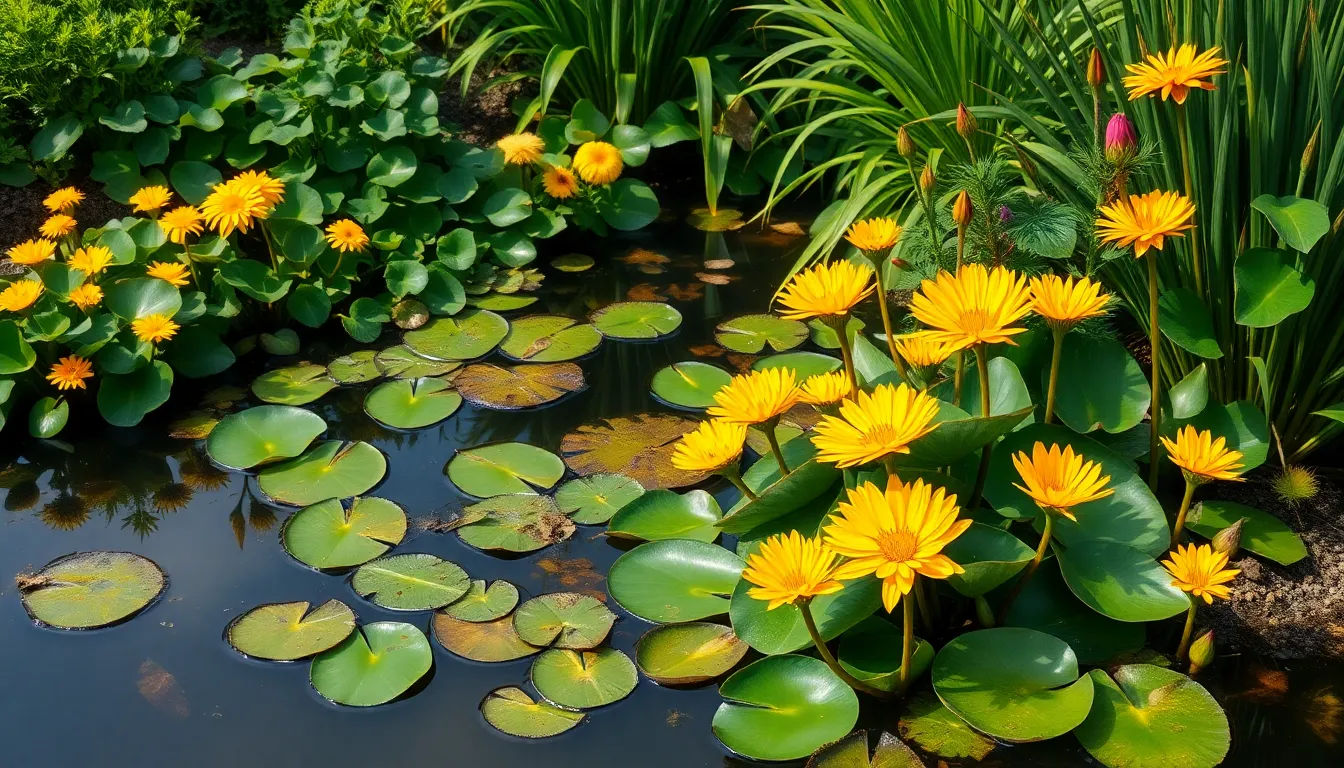
Successful pond edge planting requires strategic spacing and proactive growth management to ensure healthy plants and balanced aquatic ecosystems. We’ll explore three essential techniques that prevent common problems while maintaining your pond’s natural beauty.
Prevent Overcrowding Issues
Overcrowding creates multiple problems that can quickly destroy your pond’s ecological balance. Dense plantings reduce oxygen levels in water and encourage plant decay that harms aquatic life. We recommend maintaining about four to five bunches of underwater oxygenators per square meter to ensure adequate oxygenation without overgrowth.
Excessive shading from crowded plants blocks essential sunlight needed for healthy aquatic life. Regular thinning of established plants prevents this issue while maintaining proper water circulation. Competition for nutrients intensifies when plants grow too close together, resulting in weaker specimens that struggle to thrive.
Dividing large plant clumps annually helps maintain optimal spacing around your pond edge. This practice sustains aquatic balance by preventing any single species from dominating the network. Proper spacing also allows air circulation between plants, reducing fungal diseases and pest problems.
Plan for Mature Plant Sizes
Planning for mature plant dimensions prevents future overcrowding and maintenance headaches. Some pond edge species spread quickly or reach considerable sizes, requiring sufficient space to accommodate their natural growth patterns. We suggest researching each plant’s mature width and height before installation to avoid spacing mistakes.
Native plants like Marsh Marigolds and Water Lilies offer manageable sizes that work well in most pond settings. These species benefit local ecosystems while remaining controllable through regular care. Choosing plants suited to your exact pond size and conditions eliminates the need for constant pruning and replacement.
Deeper water aquatics like waterlilies may require repotting every couple of years to control their spread effectively. This maintenance practice keeps aggressive growers from overwhelming smaller companion plants. Proper size planning also ensures each plant receives adequate nutrients and growing space throughout the season.
Carry out Regular Pruning Schedule
Summer pruning maintains the ideal balance between plant coverage and open water surface. We recommend cutting back excess growth to keep approximately 50% of your pond surface free of vegetation for optimal light and gas exchange. This practice ensures adequate oxygen levels for fish and other aquatic life.
Removing decaying or deteriorating leaves frequently prevents nutrient buildup that leads to water quality problems. Dead plant material releases excess nutrients into the water, promoting algae growth and creating imbalanced conditions. Weekly inspection and removal of damaged foliage keeps your pond network healthy.
Autumn pruning requires cutting back marginal plants to about 15 cm above water level to encourage vigorous spring regrowth. This seasonal maintenance removes old growth while protecting root systems during winter months. Regular pruning also helps control invasive species that might otherwise dominate your pond edge plantings.
Conclusion
Creating stunning pond edges requires thoughtful plant selection and strategic placement. We’ve explored native species that thrive in moisture-rich environments while supporting local wildlife and preventing erosion.
The key lies in understanding your pond’s unique conditions and matching plants to their ideal zones. From bog plants in the wettest areas to ornamental grasses that add texture we can create seamless transitions between water and land.
Remember that successful pond gardening is an ongoing process. Regular maintenance including proper spacing and seasonal care ensures your plants remain healthy and your pond network stays balanced.
With these proven techniques you’re ready to transform your pond edge into a beautiful thriving industry that’ll provide years of enjoyment.
Frequently Asked Questions
What are the best plants for pond edges?
Native aquatic plants are ideal for pond edges as they provide natural transitions between water and land. Popular choices include water-loving irises, cardinal flower, pickerel rush, sedges, cattails, and ornamental grasses. These plants thrive in moist conditions, support local wildlife, and require minimal maintenance while creating beautiful seasonal displays.
How do I prevent erosion around my pond?
Use ground cover plants specifically designed for erosion control. Creeping Jenny forms dense mats that stabilize soil, Sweet Flag provides robust root systems for wet conditions, and Water Canna offers tropical appeal with effective erosion control. These plants create natural barriers that prevent soil displacement around pond edges.
What is the proper spacing for pond plants?
Maintain 4-5 bunches of underwater oxygenators per square meter to prevent overcrowding. Plan for mature plant sizes when spacing, allowing adequate room for growth. Group plants by moisture requirements and ensure aggressive species don’t overwhelm smaller plants. Regular thinning and annual division help maintain proper spacing.
How do bog plants differ from regular pond plants?
Bog plants thrive in consistently moist soil conditions rather than standing water. They create natural transitions at pond edges and tolerate varying moisture levels throughout seasons. Unlike submerged aquatic plants, bog plants grow in saturated soil and help bridge the gap between water and terrestrial landscapes.
When should I prune pond edge plants?
Establish a regular pruning schedule to maintain optimal light and gas exchange. Remove decaying foliage promptly to prevent water quality issues. Thin established plants regularly and divide large clumps annually. Prune aggressively growing species to control spread and maintain balanced aquatic ecosystems throughout the growing season.
How do I choose plants for different climate zones?
Research local flora and consult botanical societies for region-specific plant lists. Consider wetland species suited to your climate and observe local natural ponds for inspiration. Evaluate plants’ climate tolerance, including their ability to withstand drought, flooding, and temperature extremes specific to your geographic area.
What depth should marginal plants be planted at?
Most marginal plants require specific water depths for optimal health. Use adjustable planting shelves or pot supports to achieve precise depth control. Monitor water levels seasonally and adjust plant positions accordingly. Secure root systems properly in pond substrate to prevent displacement while maintaining healthy growth conditions.

